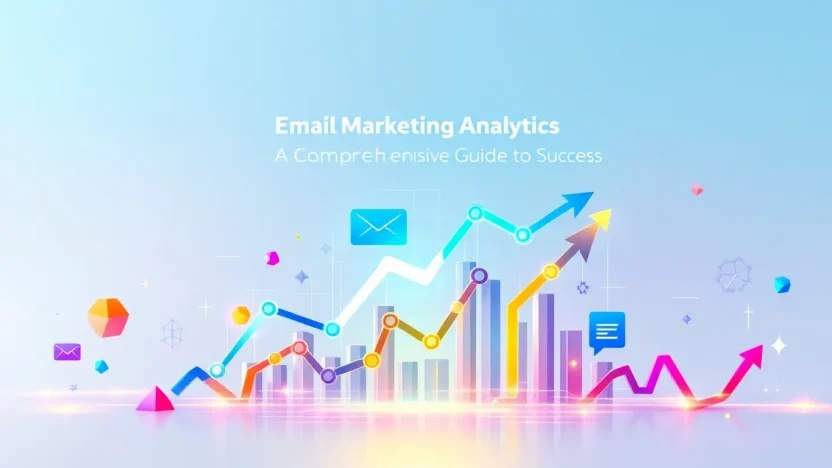Are your email campaigns hitting the mark or falling flat? In today’s competitive digital landscape, mastering email marketing analytics is no longer optional—it’s essential. Imagine uncovering the secrets behind your open rates, click-throughs, and conversions with precision!
This comprehensive guide is tailored for marketers and IT professionals eager to leverage analytics for enhanced engagement and ROI. Whether you’re a seasoned pro or just beginning, we’ll demystify the complexities and provide actionable insights to boost your email marketing success.
Ready to transform data into strategy? Let’s dive in and explore the essential components of email marketing analytics. Here’s what’s in store for you:
Table of Contents
- Understanding the Basics of Email Marketing Analytics
- Key Metrics to Track for Email Success
- Tools and Platforms for Email Marketing Analytics
- Interpretation: Turning Data into Actionable Insights
- Real-world Case Studies of Successful Email Campaigns
- FAQs
- Conclusion
Understanding the Basics of Email Marketing Analytics
Email marketing analytics is the compass that guides your campaigns toward success. But what is it exactly? Simply put, it involves tracking and analyzing various metrics that shed light on the effectiveness of your email strategies.
Why Does It Matter? Understanding these analytics is crucial for optimizing campaigns, maximizing engagement, and ultimately boosting ROI. By harnessing this data, you can tailor emails to fit your audience’s preferences, increasing their interaction and loyalty.
Key Metrics to Monitor
- Open Rate: This indicates how many recipients open your emails. A low open rate may signal the need for more enticing subject lines.
- Click-Through Rate (CTR): Measures the number of clicks on links in your email. It’s vital for assessing the content’s relevance and appeal.
- Conversion Rate: Reflects the percentage of users who completed a desired action. It’s the ultimate measure of an email’s success.
Understanding and acting on these metrics helps refine your strategy and achieve better results.
Tools for Email Marketing Analytics
Many tools can aid in analyzing these metrics more effectively. Software such as Mailchimp and Omnisend provide insights into your campaigns, helping fine-tune them for better performance.
If you want to dive deeper into email optimization, consider exploring this comprehensive guide tailored for IT companies. Armed with the right tools and knowledge, you’ll discover how to sharpen your email strategies and enhance your results.
Key Metrics to Track for Email Success
Even the best-crafted email campaign can falter without monitoring the right metrics. Tracking email marketing analytics helps you fine-tune your strategy for greater engagement and conversion. But, which metrics matter most? Let’s dive in.
- Open Rate: This metric reveals the percentage of recipients who open your email. A high open rate typically indicates your subject lines are enticing and your audience is interested. For tips on improving open rates, check out this guide.
- Click-through Rate (CTR): CTR measures how many recipients clicked a link within your email. It’s a direct indicator of the email’s effectiveness. Low CTR? You might need to rethink your call-to-action or link placements.
- Conversion Rate: After clicking through, how many people complete the desired action? Whether it’s purchasing or signing up, the conversion rate reflects your email campaign’s success.
Advanced Metrics
Diving deeper into email marketing analytics:
- Bounce Rate: A high bounce rate could signal issues with your email list’s quality or deliverability.
- Unsubscribe Rate: Regularly track who opts out to understand content pitfalls.
- Spam Complaints: Frequent spam complaints can harm your sender reputation and future email success.
Tracking essential metrics like open rates and CTRs enable smarter strategy adjustments, leading to more successful campaigns.
Benchmarking Your Metrics
Industry benchmarks provide a useful yardstick to measure your campaigns against peers. For IT companies, compare your metrics to see where you stand and focus on improvement areas. Considering average rates helps identify areas needing attention, ensuring your analytics are more than just numbers but actionable insights.
| Metric | Average Rate |
|---|---|
| Open Rate | 20-30% |
| CTR | 2-5% |
| Conversion Rate | 1-3% |
In summary, focusing on pivotal metrics like open and conversion rates within your email marketing strategy can significantly boost results and drive IT business success.
Tools and Platforms for Email Marketing Analytics
Email marketing analytics provide vital insights into your campaigns, making it possible to optimize and achieve better results. Choosing the right tools and platforms can dramatically enhance how effectively you track metrics and make data-driven decisions. But what tools should you consider for maximum impact? Let’s dive in!
- Google Analytics Integration: Google Analytics provides powerful insights by integrating with your email service provider. It tracks user behavior from clicks to conversions, helping you understand paths users take through your website. This integration is crucial for comprehensive email marketing analytics.
- Mailchimp: Known for its user-friendly platform, Mailchimp not only allows email creation and scheduling but also delivers robust analytics. Track click-through rates, open rates, and conversion data effortlessly.
- HubSpot: With its extensive set of features, HubSpot empowers you to manage your email marketing analytics comprehensively. Its dashboard offers real-time data on engagement, providing actionable insights essential for growth.
- Sendinblue: Offering an array of features for both beginners and professionals, Sendinblue excels in delivering detailed analytical reports. Quickly identify which campaigns resonate with your audience.
Evaluating Email Analytics Platforms
When evaluating email analytics platforms, consider factors such as ease of use, integration capabilities with existing systems, and the depth of analytics offered. Ensure the platform aligns with your specific needs, whether that means focusing on advanced segmentation features or seamless integration with your CRM.
Tools that simplify email marketing analytics provide a competitive edge, offering clarity into customer engagement and enabling strategy refinement.
For further reading on refining your email marketing strategies, explore email optimization techniques. Selecting the right platform not only aids in tracking but turns data into powerful stories that drive results—fueling your business success.
Interpretation: Turning Data into Actionable Insights
Email marketing analytics might seem like a maze of numbers and graphs, but understanding it can transform your campaigns. Let’s talk about finding those golden insights. Start by diving into your click-through rates and conversion metrics. Why do they matter? Because they reveal how engaging your content is, guiding what works and what doesn’t.
Imagine launching a new campaign with high hopes, only to see low engagement. Disappointing, right? This is where our trusty email marketing analytics come in. Analyzing these numbers reveals unexpected patterns and correlations.
- Spotting trends: Regularly reviewing metrics highlights patterns over time. A sudden drop in open rates? It might hint at subject lines that miss the mark.
- Segmentation success: Analyzing segmented data can show which audience groups respond best, similar to how a key fits a lock, tailoring future messages more accurately.
- CTR breakdown: Specific link performance analysis shows what attracts attention—maybe it’s those catchy CTAs or stunning graphics.
Tools for Analysis
Ever felt lost amidst emails and metrics? Streamline your strategy with tools like Google Analytics. They connect your measurement dots, forming a clear picture of your efforts. And while you’re at it, consider learning from email optimization strategies for further refinement.
Key benefit: Leveraging email marketing analytics empowers data-driven decisions, transforming your approach.
Example Table Highlight: Here’s how structured analysis transforms insights into action:
| Metric | Insight | Action |
|---|---|---|
| Open Rate | Low engagement on Mondays | Send on Wednesdays instead |
| CTR | High clicks on product links | Enhance promotion of popular items |
Real-world Case Studies of Successful Email Campaigns
Email marketing analytics can transform your campaigns by providing insights that drive real results. Imagine how much more effective your emails might be with data-backed strategies? Dive into these success stories to uncover what works best.
Case Study: Tech Giant’s Product Launch
A leading tech company leveraged email marketing analytics during a major product launch. By analyzing open rates and segmenting their audience, they saw a 25% increase in engagement. Personalized subject lines, informed by analytics, led to higher conversion rates.
Key takeaway: Analytics can enhance personalization, improving engagement and conversion rates.
Case Study: Startup’s Subscriber Growth
A tech startup used email marketing analytics to double its subscriber list in six months. By refining their content based on engagement metrics, they crafted emails that truly resonated. This approach not only increased their subscriber base but also fostered stronger connections.
- Targeted messaging boosts sign-ups and retention.
- Data-driven decisions lead to more effective emails.
These case studies highlight the power of analytics to elevate your campaigns. Want more insights? Check out this detailed guide on email optimization to apply similar strategies.
| Company | Strategy Used | Result |
|---|---|---|
| Tech Giant | Segmentation & Personalization | 25% Lift in Engagement |
| Startup | Content Refinement | 100% Subscriber Growth |
These examples illustrate that with the right use of email marketing analytics, even small adjustments can yield substantial results. What will your next campaign look like?
FAQs
Understanding Email Metrics
What are the key metrics in email marketing analytics? Typical metrics include open rate, click-through rate, and conversion rate. These metrics help gauge how well your emails engage and convert your audience.
Improving Open Rates
How can I improve my open rates? Focus on crafting compelling subject lines and ensuring personalization. A/B testing subject lines can also significantly boost your open rates and enhance overall email optimization.
Determining Campaign Success
How do I know if my email campaign is successful? Success is measured by analyzing analytics such as engagement rates and ROI. Set clear goals and KPIs before sending campaigns to track effectiveness easily.
Role of Segmentation
How does segmentation affect email campaigns? Segmentation allows for targeted messaging, increasing relevance for each recipient and leading to higher engagement and better performance in email marketing analytics.
Conclusion
In the realm of digital marketing, mastering email marketing analytics is paramount for success. By harnessing data effectively, you can refine your strategies, boost engagement, and drive conversions. Start today with optimized email strategies to stay ahead. With every insight, you’re not just learning; you’re evolving towards refined marketing excellence.



